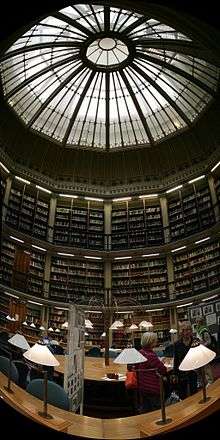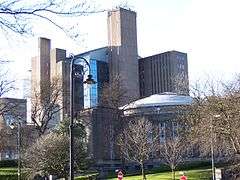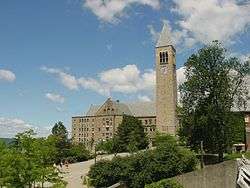Academic library






An academic library is a library that is attached to a higher education institution which serves two complementary purposes to support the school's curriculum, and to support the research of the university faculty and students.[1] It is unknown how many academic libraries there are internationally. An academic and research portal maintained by UNESCO links to 3,785 libraries. According to the National Center for Education Statistics, there are an estimated 3,700 academic libraries in the United States.[1] The support of teaching and learning requires material for class readings and for student papers. In the past, the material for class readings, intended to supplement lectures as prescribed by the instructor, has been called reserves. In the period before electronic resources became available, the reserves were supplied as actual books or as photocopies of appropriate journal articles.
Academic libraries must determine a focus for collection development since comprehensive collections are not feasible. Librarians do this by identifying the needs of the faculty and student body, as well as the mission and academic programs of the college or university. When there are particular areas of specialization in academic libraries, these are often referred to as niche collections. These collections are often the basis of a special collection department and may include original papers, artwork, and artifacts written or created by a single author or about a specific subject.
There is a great deal of variation among academic libraries based on their size, resources, collections, and services. The Harvard University Library is considered to be the largest strict academic library in the world,[2] although the Danish Royal Library—a combined national and academic library—has a larger collection.[3] Another notable example is the University of the South Pacific which has academic libraries distributed throughout its twelve member countries.[1] The University of California operates the largest academic library system in the world, it manages more than 34 million items in 100 libraries on ten campuses.
History
United States
The first colleges in the United States were intended to train members of the clergy. The libraries associated with these institutions largely consisted of donated books on the subjects of theology and the classics. In 1766, Yale had approximately 4,000 volumes, second only to Harvard.[4] Access to these libraries was restricted to faculty members and a few students: the only staff was a part-time faculty member or the president of the college.[5] The priority of the library was to protect the books, not to allow patrons to use them. In 1849, Yale was open 30 hours a week, the University of Virginia was open nine hours a week, Columbia University four, and Bowdoin College only three.[6] Students instead created literary societies and assessed entrance fees in order to build a small collection of usable volumes often in excess of what the university library held.[6]
Around the turn of the century, this approach began to change. The American Library Association was formed in 1876, with members including Melvil Dewey and Charles Ammi Cutter. Libraries re-prioritized in favor of improving access to materials, and found funding increasing as a result of increased demand for said materials.[7]
Academic libraries today vary in regard to the extent to which they accommodate those who are not affiliated with their parent universities. Some offer reading and borrowing privileges to members of the public on payment of an annual fee; such fees can vary greatly. The privileges so obtained usually do not extend to such services as computer usage, other than to search the catalog, or Internet access. Alumni and students of cooperating local universities may be given discounts or other consideration when arranging for borrowing privileges. On the other hand, access to the libraries of some universities is absolutely restricted to students, faculty, and staff. Even in this case, they may make it possible for others to borrow materials through inter-library loan programs.
Libraries of land-grant universities generally are more accessible to the public. In some cases, they are official government document repositories and so are required to be open to the public. Still, members of the public are generally charged fees for borrowing privileges, and usually are not allowed to access everything they would be able to as students.
Canada
Academic libraries in Canada are a relatively recent development in relation to other countries. The very first academic library in Canada was opened in 1789 in Windsor, Nova Scotia.[8] Academic libraries were significantly small during the 19th century and up until the 1950s, when Canadian academic libraries began to grow steadily as a result of greater importance being placed on education and research.[8] The growth of libraries throughout the 1960s was a direct result of many overwhelming factors including inflated student enrollments, increased graduate programs, higher budget allowance, and general advocacy of the importance of these libraries.[9] As a result of this growth and the Ontario New Universities Library Project that occurred during the early 1960s, 5 new universities were established in Ontario that all included fully catalogued collections.[8] The establishment of libraries was widespread throughout Canada and was furthered by grants provided by the Canada Council and the Social Sciences and Humanities Research Council, which sought to enhance library collections.[8] Since many academic libraries were constructed after World War Two, a majority of the Canadian academic libraries that were built before 1940 that have not been updated to modern lighting, air conditioning, etc., are either no longer in use or are on the verge of decline.[10] The total number of college and university libraries increased from 31 in 1959-1960 to 105 in 1969-1970.[11]
Following the growth of academic libraries in Canada during the 1960s, there was a brief period of sedation, which was a primary result of some major budgetary issues.[12] These academic libraries were faced with cost issues relating to the recently developed service of interlibrary lending and the high costs of periodicals on acquisition budgets, which affected overall acquisition budgeting and ultimately general collections.[12] Canadian academic libraries faced consistent problems relating to insufficient collections and overall lack of coordination among collections.[13]
Academic libraries within Canada would not have flourished and continue to be strengthened without the help of outside organizations. The Ontario Council of University Libraries (OCUL) was established in 1967 and is concerned with promoting unity among Canadian academic libraries.[14] The Ontario College and University Library Association (OCULA) is attached to the Ontario Library Association (OLA) and is concerned with representing academic librarians in regards to issues that are shared in the academic library setting.[15]
See also
Notes and references
- 1 2 3 Curzon, Susan; Jennie Quinonez-Skinner (9 September 2009). "Academic Libraries". Encyclopedia of Library and Information Sciences. doi:10.1081/E-ELIS3-120044525. Retrieved 10 September 2013.
- ↑ Pezzi, Bryan (2000). Massachusetts. Weigl Publishers. p. 15. ISBN 1-930954-35-2.
- ↑ "Årsberetning 2015" (PDF) (in Danish). 2015. Retrieved 2017-08-28.
- ↑ Budd, John M. (1998). The Academic Library: Its Context, Its Purpose, and Its Operation. Englewood, Colorado: Libraries Unlimited. pp. 30–31.
- ↑ McCabe, Gerard; Ruth J. Person (1995). Academic Libraries: Their Rationale and Role in American Higher Education. Westport, Connecticut: Greenwood Press. pp. 1–3.
- 1 2 Budd (1998), p. 34
- ↑ McCabe (1995), pp. 1-3.
- 1 2 3 4 Beckman, M.; Dahms, M.; Lorne, B. (2010). "Libraries".
- ↑ Downs, R. B. (1967). Resources of canadian academic and research libraries. Ottawa, ON.: Association of Universities and Colleges of Canada. p. 9.
- ↑ Downs, R. B. (1967). Resources of canadian academic and research libraries. Ottawa, ON.: Association of Universities and Colleges of Canada. p. 93.
- ↑ Downs, R. B. (1967). Resources of canadian academic and research libraries. Ottawa, ON.: Association of Universities and Colleges of Canada. p. 4.
- 1 2 University research libraries: Report of the consultative group on university research libraries. Ottawa, ON: The Canada Council. 1978. p. 4.
- ↑ University research libraries: Report of the consultative group on university research libraries. Ottawa, ON: The Canada Council. 1978. p. 2.
- ↑ "A History of Collaboration". Ontario Council of University Libraries. 2011. Archived from the original on 2012-08-26. Retrieved 2017-02-17.
- ↑ Ontario Library Association (n.d.). "About OCULA". Archived from the original on 6 December 2011.
Further reading
- Jürgen Beyer, « Comparer les bibliothèques universitaires », Arbido newsletter 2012:8
- Ellsworth, Ralph E. (1973) Academic library buildings: a guide to architectural issues and solutions 530 pp. Boulder: Associated University Press
- Giustini, Dean (2011, 3 May) Canadian academic libraries' use of social media, 2011 update [Web log post]. Retrieved from http://blogs.ubc.ca/dean/2011/05/canadian-academic-libraries-use-of-social-media-2011-update/
- Hamlin, Arthur T. (1981). The University Library in the United States: Its Origins and Development. Philadelphia: University of Pennsylvania Press. ISBN 9780812277951
- Hunt, C. J. (1993) "Academic library planning in the United Kingdom", in: British Journal of Academic Librarianship; vol. 8 (1993), pp. 3–16
- Shiflett, Orvin Lee (1981). Origins of American Academic Librarianship. Norwood, N.J.: Ablex Pub. Corp. ISBN 9780893910822
- Taylor, Sue, ed. (1995) Building libraries for the information age: based on the proceedings of a symposium on The Future of Higher Educational Libraries at the King's Manor, York 11–12 April 1994. York: Institute of Advanced Architectural Studies, University of York ISBN 0-904761-49-5
